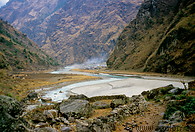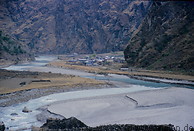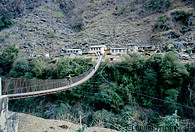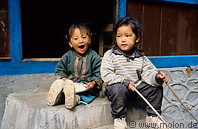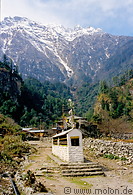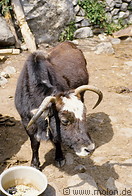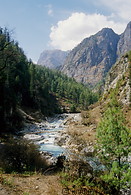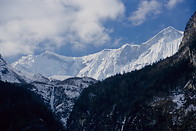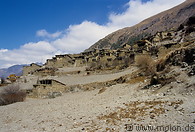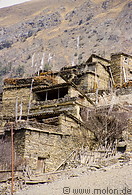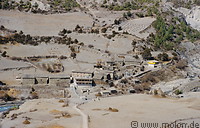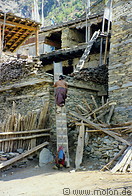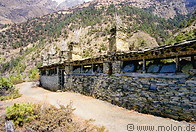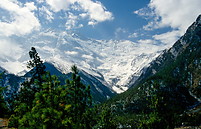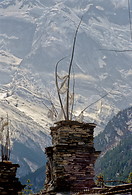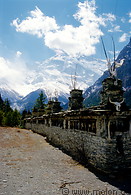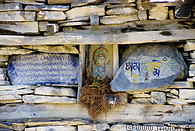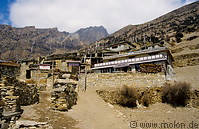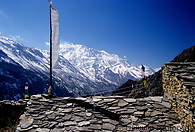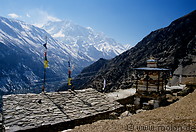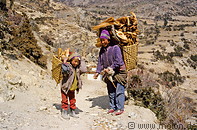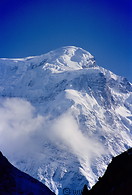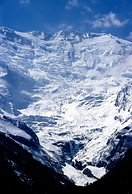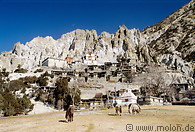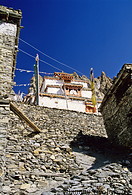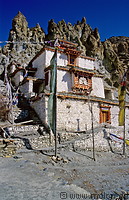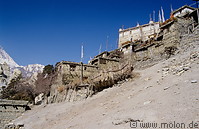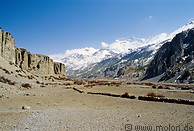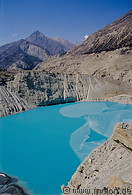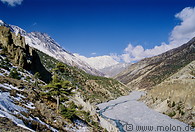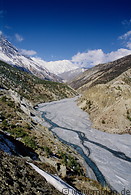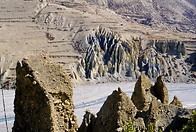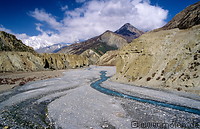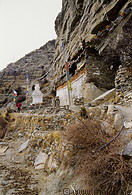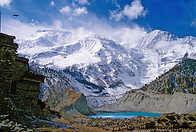You approach Tal (1700 m) after having conquered another hard piece of trail. The valley is very narrow and deep and there are some quite good views. That's not surprising, as during the first days of trek everything is new, and I could have stood still for hours looking around. I didn't meet many people, and rarely other trekkers. The vegetation changes to fir trees and you feel something is changing. The people in Tal are Buddhists of Tibetan ancestry, the buildings are out of stone with flat roofs. Tal looks like a village out of a "western" movie, and it's a great place to stay. You also have to register at the police check point.
The trail continues in a rather deep gorge, you don't see much of the mountains, as the slopes are very steep and high. You cross another long suspension bridge. The Marsyandi is fantastic, rough and clear, big rocks define the riverbed. When you get out of the gorge you are in Bagarchap (2160 m) and the valley opens again. I walked alone and enjoyed very much the peace around me, no cars, no crowds, no pollution, just me, the river and the mountains (without having to panic about nothing, as every two hours you reach another village).
The route continues through pine and fir forests, always following the Marsyandi river. Very often you see some Buddhist symbols like mani walls and prayer wheels, and the entrance to the villages is defined by a large stony gate. Chame (2670 m) is actually a great place to stay, but in Bhratang you first get a great view on the Annapurna II peak. From now on you walk very close to the principal range and can nearly touch them all the time.
In order to enjoy them most I chose the upper route, a great deal of climbing at an altitude, where altitude sickness can already be problem. Actually you should climb high and sleep low, so this is what I did: I climbed up to 3670 in Ghyaru and finally slept in Braga, at 3450 m. Braga and its 500 years old gompa are fantastic, a little village 500 m before you reach Manang, but with a great lodge and wonderful bakery and the famous gompa. From there I remember spectacular views on the Annapurnas. I opened the window in the morning and stayed still without believing it: magic moments!
Manang is a good place as well. Many lodges, good bakeries, lots of side trips: Khangsar, the glacier lake, the Tsamkhang with the old lama. I spent there more time than I wanted, because I became sick (and cured by the magical hands of the doctors at the Rescue Centre). The surroundings are worth a visit and usually most trekkers spend more than one night here, so you make lots of friends and meet those people you will cross the pass with. It is most important that you don't walk alone above these altitudes, as altitude sickness is unpredictable and can become very dangerous if not early recognised. The Himalaya Rescue Centre holds daily lectures about the risks and what you can do to climb without encountering any problem.
The trail continues in a rather deep gorge, you don't see much of the mountains, as the slopes are very steep and high. You cross another long suspension bridge. The Marsyandi is fantastic, rough and clear, big rocks define the riverbed. When you get out of the gorge you are in Bagarchap (2160 m) and the valley opens again. I walked alone and enjoyed very much the peace around me, no cars, no crowds, no pollution, just me, the river and the mountains (without having to panic about nothing, as every two hours you reach another village).
The route continues through pine and fir forests, always following the Marsyandi river. Very often you see some Buddhist symbols like mani walls and prayer wheels, and the entrance to the villages is defined by a large stony gate. Chame (2670 m) is actually a great place to stay, but in Bhratang you first get a great view on the Annapurna II peak. From now on you walk very close to the principal range and can nearly touch them all the time.
In order to enjoy them most I chose the upper route, a great deal of climbing at an altitude, where altitude sickness can already be problem. Actually you should climb high and sleep low, so this is what I did: I climbed up to 3670 in Ghyaru and finally slept in Braga, at 3450 m. Braga and its 500 years old gompa are fantastic, a little village 500 m before you reach Manang, but with a great lodge and wonderful bakery and the famous gompa. From there I remember spectacular views on the Annapurnas. I opened the window in the morning and stayed still without believing it: magic moments!
Manang is a good place as well. Many lodges, good bakeries, lots of side trips: Khangsar, the glacier lake, the Tsamkhang with the old lama. I spent there more time than I wanted, because I became sick (and cured by the magical hands of the doctors at the Rescue Centre). The surroundings are worth a visit and usually most trekkers spend more than one night here, so you make lots of friends and meet those people you will cross the pass with. It is most important that you don't walk alone above these altitudes, as altitude sickness is unpredictable and can become very dangerous if not early recognised. The Himalaya Rescue Centre holds daily lectures about the risks and what you can do to climb without encountering any problem.

